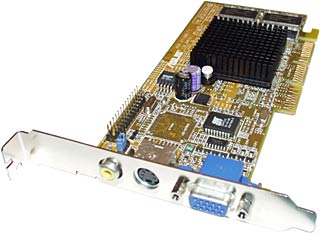Over bij Dan's Data is een review te vinden van de Asus V7100/T GeForce2 MX kaart, waarbij die "T" staat voor de video versie; hij is uitgerust met een TV output en een videoconnector:
The V7100/T has both composite and S-Video connectors on the back, as well as the 15 pin VGA socket. The dual connectors can't be used at once, but it's a better solution than the non-standard combo-plug that many cards use to cut costs; they come with an adaptor lead without which you can't use composite output. Other cards again have S-Video output only, which is all very well if you've got a funky TV or VCR with Y/C input, but no good for a lot of people.
With both kinds of connector, you can play your games on your big TV (in 800 by 600 or 640 by 480; TVs aren't very sharp screens), or use your DVD-ROM drive equipped computer as a cheap DVD player, and not have to worry about making the awful discovery that Tab A can by no means be plugged into Slot B.
[break]Na even met de kaart getweaked te hebben wist Dan hem op 210/210MHz te krijgen wat resulteerde in een performance boost van zo'n 15%. Hierdoor zou de Asus V7100 niet veel trager zijn dan een GeForce DDR kaart in de gangbare resoluties:[/break] For $AUD300 or so, this thing's significantly faster than a plain, non-DDR original GeForce board, even before you start fooling around with overclocking. By the time the MX is locally available, plain GeForce boards will probably cost about the same as it.
Wind up the core and RAM speeds, and the MX gives you GeForce DDR performance, for quite a bit less money. It's not far behind even without overclocking. And I doubt the DDR boards will fall in price enough to make them better value.
Where the GeForce DDR and the GeForce2 GTS shine, of course, is in very high resolutions. Even overclocked, the GeForce2 MX's RAM lets it down if you want to go much above 1280 by 960. At 1600 by 1200, a DDR GeForce will show an MX a clean pair of heels, and a GeForce2 GTS will be a dot in the distance.
 |

